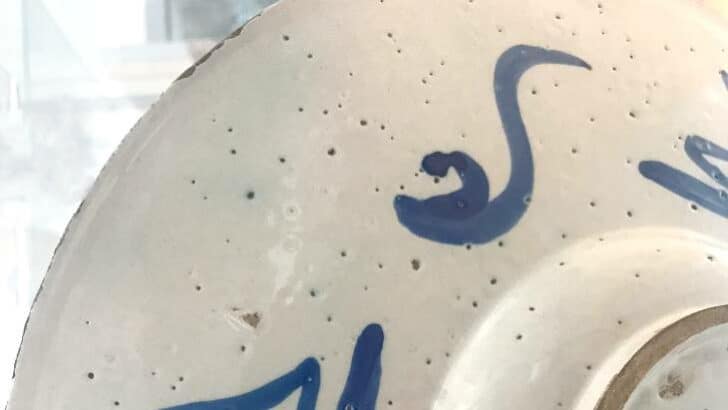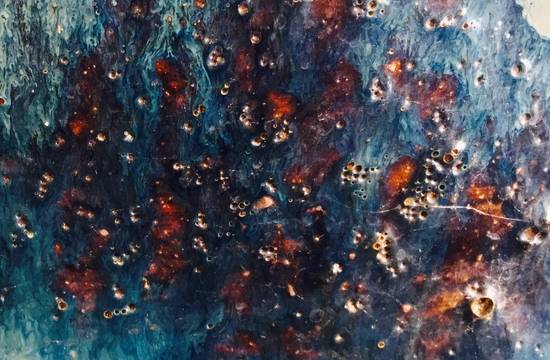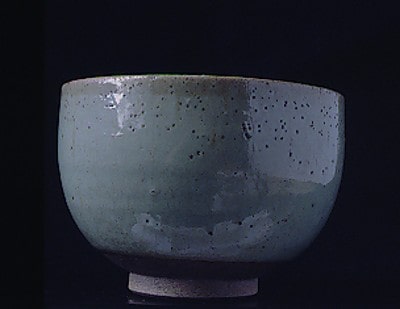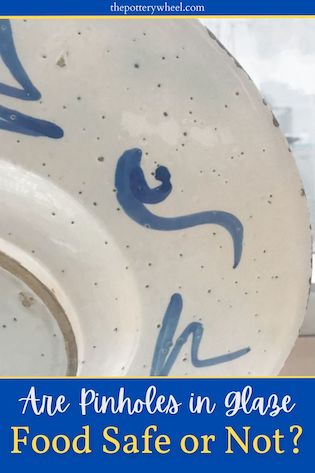Your cart is currently empty!
Are Pinholes in Glaze Food Safe? – Keep It Or Trash It?
Published:
Last Updated:

Affiliate Disclaimer
As an affiliate, we may earn a commission from qualifying purchases. We get commissions for purchases made through links on this website from Amazon and other third parties.
Pinholes in pottery glaze can ruin the look of a piece. They are a pest and a disappointment when you unload the kiln. But a more pressing question is whether pinholes in glaze are food safe. Can the affected pots be used, or do they need to go into the trash?
It’s often said that pinholes in glaze are not food safe because they can harbor old food and bacteria. The food industry and commercial manufacturers are expected to follow strict guidelines about what kinds of surfaces are suitable for contact with food. However, individual potters have divided opinions about whether pinholes are a serious glaze defect or not.
In this article, we will look at the data and research so you can reach your own conclusions…
What Are Pinholes and What Causes Them?
Pinholes are a glaze defect. They are small holes in the surface of the glaze. These holes reach all the way from the glaze surface to the underlying clay body and are about the size of a pinhead.
Like most pottery glaze defects, there are quite a few different causes of pinholes. One of the most common causes is gases escaping from the pottery clay and glaze during the firing schedule.
When clay and glaze are fired in the kiln organic and carbonaceous matter in the pottery is burned out and creates gases. These gases form small bubbles in the pottery glaze when it is in its molten state.
Ideally, the bubbles rise to the surface of the glaze and burst. The liquid glaze surface then heals over and becomes smooth before the firing cycle ends and the kiln starts to cool.
However, sometimes the holes don’t have enough time to heal over. This can be because the firing cycle was too fast or short. Or because the glaze was quite ‘stiff’ and it took the bubbles too long to work their way to the surface. And the glaze wasn’t fluid enough to heal over any pock marks left behind.
However, there are a number of other causes of pinholes in pottery. Some of these include the following:
- An overly thick application of pottery glaze
- Dust and debris on the bisque surface before firing
- Underfired bisqueware
- Pottery clay and glaze combinations that don’t work well together

You can read more about the causes of pinholes here.
Are Pinholes in Pottery Glaze Food Safe?
Pinholes in glaze are a common problem. Most potters who have fired a kiln more than a few times are likely to have encountered them.
Some potters don’t mind the look of them too much. Personally, the pimply texture gives me the heebie jeebies. But, my personal feelings about them aside, are pinholes in glaze food safe? Let’s take a look at that question now.
Concerns About Pinholes in Glaze – Are they Food Safe?
One of the main concerns about pinholes is that they act as tiny crevices in your pottery surface that can act as a harbor for food and bacteria. Imagine wiping butter on a highly textured surface like a pumice stone, and then trying to clean the butter out of the holes.
The worry with pinholes is that once food is lodged in the gap, it will be very hard to get out again. As a result, old food is thought to be a breeding ground on your dinnerware for pathogens.
This sounds like quite straightforward common sense. One of the purposes of pottery glaze is to provide a glassy seal on the surface of your pottery. And if the seal is broken with a pinhole, or some other glaze defect, then the glaze isn’t doing its job, right?
Well, not everyone agrees. I’ve spoken to a number of potters who feel quite relaxed about pinholes in the surface of their glaze. Why is that? Here are some of the reasons they gave me…
- Provided the pottery is washed effectively, the food and grime can be removed. Effective washing can be achieved with warm soapy water or ideally a dishwasher.
- If the pottery is vitrified, then pinholes are only a surface defect. Vitrified or mature clay bodies don’t absorb liquids or food matter. If the pot is cleaned effectively, there shouldn’t be any residual food left behind to cause contamination.
- Pinholes are not a sign of glaze instability. Some glazes are unstable and leach toxins into foodstuff and liquid. Leaching is a serious hazard with unstable glazes. Some potters argue that in comparison to ‘serious’ glaze issues like leaching, pinholes are an aesthetic problem rather than a food safety issue.
Differences of Opinion
So, you will see that some potters are not overly concerned about the presence of pinholes.
However, not everyone is on the same page with this. And here are some of the reasons why…
Effective Cleaning
Pinholes can make cleaning pottery less straightforward. It may be that if you wash your pots carefully, or put them in a dishwasher, this will get rid of residual food.
But my thinking is that ideally pottery should be made so that you don’t have to take extra measures to make sure that it’s safe to use.
This is particularly the case when I’m selling my pottery. I don’t want to have to advise buyers to wash my mugs or plates especially well to make sure that the pinholes are clean.
Dishwashers are good at sterilizing eating utensils. But not everyone owns a dishwasher, and not everyone wants to put their hand-crafted pottery into a dishwasher.
Many pieces of stoneware pottery are sold as being dishwasher safe. And whilst your stoneware may survive a dishwasher cycle, over time washing pottery in a dishwasher can make the glaze go dull. You can read more about washing your pottery in the dishwasher here. Personally, I handwash pottery that has been handmade.

via Wikimedia Commons. Image is cropped
Research
I’m not aware of any particular research studies that have been conducted into whether pinholes in glaze are food safe. However, there was an interesting article published by the Ceramic Arts Network about crazed glazes (source).
Whilst this study was about crazing rather than pinholes, I think some of the findings are relevant to pinholes too.
Their team of researchers recorded some data about whether pottery with a crazed glaze could be cleaned effectively.
In the study, they made test tiles that were glazed with a crazed and a non-crazed glaze. They then smeared a common bacteria on the test tiles and incubated the bacteria on the different glazed surfaces.
After a period of incubation, they used a few different ways of cleaning the test tiles. These ranged from wiping the surface with a paper towel to putting them in a dishwasher.
Findings
It was found that both soap and water, and using a dishwasher did clean the surface with the crazed glaze. As a result, the article concluded the commonly held belief amongst potters that crazed glazes are not food safe was a myth.
However, they did acknowledge that even after washing with soap and water the crazed surface was less clean than the non-crazed surface. And they said that ideally crazed dishes should be washed in a dishwasher to ensure that they are food safe.
Although this experiment was about crazed glazes, it’s not hard to imagine that the findings would be similar to pinholes. Pinholes are deep craters in the surface of the glaze that can act as reservoirs for grease and protein from food to become lodged.
Restaurants and Ceramics Manufacturers
When it comes to whether pinholes in glaze are food safe, I think it’s helpful to look towards industrial standards.
In the ceramics industry, if a piece of ceramicware has a pinhole in the surface, it becomes a reject. Industrial producers invest huge time and money in sourcing materials that will prevent the occurrence of glaze defects. This is because they can’t sell items with issues like pinholes as being food-safe functional ware (source).
The Food Code 2013 published by the FDA sets out guidelines on equipment used in industries preparing and serving food such as restaurants. Amongst the many guidelines, this code states that ‘food-contact’ surfaces need to be made from materials that have a ‘smooth, easily cleanable surface’. It also states that the surfaces are ‘resistant to pitting, chipping, crazing, scratching, scoring, distortion, and decomposition’ (source).
It’s for these reasons that many restaurants won’t use ceramic ware that has a finish that can be classified as a glaze defect, including pinholes.
But does this apply to small-scale potters and individual artisan makers?
Individual Potters and Small Scale Potteries
Individual potters will have different opinions about whether pinholes in glaze are food safe. Some potters will classify pieces with pinholes as being rejects. They are consigned to the trash and chalked up as a learning curve.
Other potters are happy to use pottery with pinholes for their own personal use, but would not include them in the pieces that they sell.
The other option is to sell pieces with pinholes as being ‘seconds’. These are pots that are known to have imperfections and are sold at a reduced price.
Exactly what you do with pieces that have pinholes in the glaze is a matter of personal preference.
Part of your decision-making may depend upon how many pinholes are affecting the glaze. One pinhole here and there may not stop you from using a mug for personal use. But if the whole of the glazed surface is affected, this may be a different matter.
Whether a piece is food safe or not, is not the only deciding factor too. There are aesthetic considerations. A lot of potters, myself included, don’t want to sell pottery with pinholes in the glaze because it may reflect badly on your craftsmanship.

Final Thoughts
There is some evidence to suggest that food and bacteria can be cleaned from pinholes in pottery with thorough cleaning practices. However, glazes with defective surfaces are harder to clean, and the food service industry is required to use surfaces that are smooth and easy to clean.
What individual potters do with pieces affected by pinholing will vary from potter to potter. Many potters believe that pinholes in glaze are not food safe. Whilst others take a more relaxed approach to items that they will be using themselves or selling as seconds.



